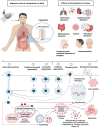Microplastic sources, formation, toxicity and remediation: a review
- PMID: 37362012
- PMCID: PMC10072287
- DOI: 10.1007/s10311-023-01593-3
Microplastic sources, formation, toxicity and remediation: a review
Abstract
Microplastic pollution is becoming a major issue for human health due to the recent discovery of microplastics in most ecosystems. Here, we review the sources, formation, occurrence, toxicity and remediation methods of microplastics. We distinguish ocean-based and land-based sources of microplastics. Microplastics have been found in biological samples such as faeces, sputum, saliva, blood and placenta. Cancer, intestinal, pulmonary, cardiovascular, infectious and inflammatory diseases are induced or mediated by microplastics. Microplastic exposure during pregnancy and maternal period is also discussed. Remediation methods include coagulation, membrane bioreactors, sand filtration, adsorption, photocatalytic degradation, electrocoagulation and magnetic separation. Control strategies comprise reducing plastic usage, behavioural change, and using biodegradable plastics. Global plastic production has risen dramatically over the past 70 years to reach 359 million tonnes. China is the world's top producer, contributing 17.5% to global production, while Turkey generates the most plastic waste in the Mediterranean region, at 144 tonnes per day. Microplastics comprise 75% of marine waste, with land-based sources responsible for 80-90% of pollution, while ocean-based sources account for only 10-20%. Microplastics induce toxic effects on humans and animals, such as cytotoxicity, immune response, oxidative stress, barrier attributes, and genotoxicity, even at minimal dosages of 10 μg/mL. Ingestion of microplastics by marine animals results in alterations in gastrointestinal tract physiology, immune system depression, oxidative stress, cytotoxicity, differential gene expression, and growth inhibition. Furthermore, bioaccumulation of microplastics in the tissues of aquatic organisms can have adverse effects on the aquatic ecosystem, with potential transmission of microplastics to humans and birds. Changing individual behaviours and governmental actions, such as implementing bans, taxes, or pricing on plastic carrier bags, has significantly reduced plastic consumption to 8-85% in various countries worldwide. The microplastic minimisation approach follows an upside-down pyramid, starting with prevention, followed by reducing, reusing, recycling, recovering, and ending with disposal as the least preferable option.
Keywords: Biodegradable plastics; Microplastic control; Microplastic detection; Microplastic pollution; Microplastic toxicity; Water treatment.
© The Author(s) 2023.
Conflict of interest statement
Conflict of interestThe authors declare no conflict of interest.
Figures






References
-
- Abdel Maksoud MIA, et al. Insight on water remediation application using magnetic nanomaterials and biosorbents. Coordination Chem Rev. 2020;403:213096. doi: 10.1016/j.ccr.2019.213096. - DOI
-
- Abdelfatah AM, et al. Efficient adsorptive removal of tetracycline from aqueous solution using phytosynthesized nano-zero valent iron. J Saudi Chem Soc. 2021;25(12):101365. doi: 10.1016/j.jscs.2021.101365. - DOI
Publication types
LinkOut - more resources
Full Text Sources
Miscellaneous
